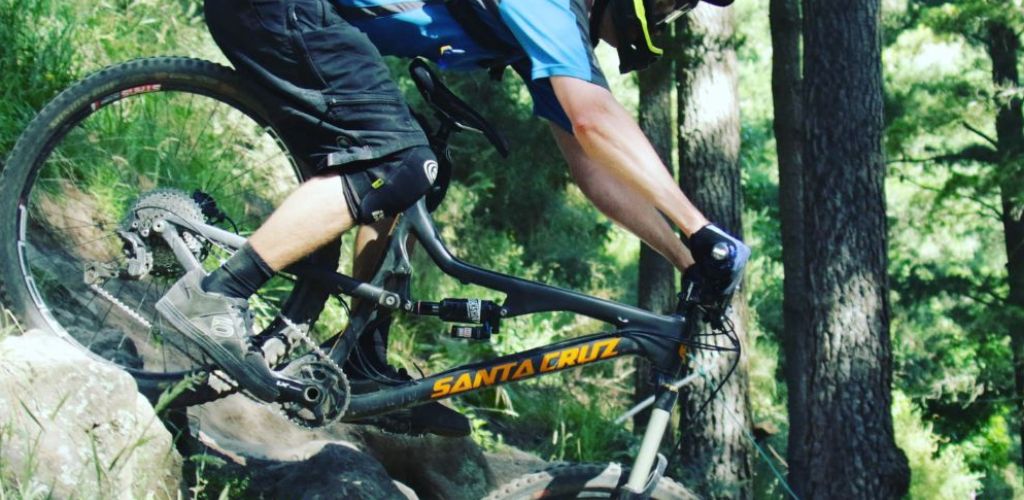In this article, I’ll delve into the reasons why knee pads are a crucial part of a mountain biker’s attire, focusing on protection, comfort, performance, and types of knee pads available.
Protection: The Primary Reason
The primary reason for wearing knee pads in mountain biking is protection. The terrain in mountain biking is unpredictable and often rough, with a high risk of falls and collisions. Your knees, being one of the most vulnerable parts of your body, are especially at risk.
Often during a crash, hands and knees will come in contact with the ground with some force, so a good set of gloves and knee pads can really go a long way to mitigating the painful effects of a crash!
Unfortunately I have tested this out far too many times!
Impact Protection
During a fall, the knees often bear the brunt of the impact. Knee pads provide a layer of cushioning, absorbing the shock and reducing the severity of injuries. They protect against cuts, bruises, and more serious injuries like fractures or ligament damage. They’re not always foolproof, as they can of course move around during a crash, or just be unable to protect you against a very high speed or high impact crash – but they do a great job in most impacts.
Abrasion Resistance
Mountain biking trails are filled with rocks, branches, and rough terrain. Knee pads offer a protective barrier against scrapes and abrasions, shielding the skin from direct contact with these harsh elements. This is just one reason that I have more scars on my shins and elbows than I do on my knees!
Knee pads can’t be too uncomfortable
Comfort is key in any sport, and mountain biking is no exception. Well-designed knee pads not only protect but also do not detract from the riding experience by by being comfortable throughout the ride.
Ergonomic Design
Modern knee pads are designed ergonomically to fit the contours of your knees, allowing for a full range of motion. This design ensures that the pads stay in place, reducing the need for constant readjustment and allowing you to focus on the trail.
Breathability and Moisture Management
High-quality knee pads are made with breathable materials that help in managing sweat and heat. Ventilation is crucial for long rides, as it prevents discomfort and skin irritation caused by excessive sweating. Some mountain bikers will argue that they can’t stand wearing any knee pads due to excess sweating and heat, but personally I’ve never had a problem with them – especially a light weight pair like my IXS Flows.

Performance: Supporting Aggressive Riding
For those who like to push their limits, knee pads can actually aid in performance. They provide not just safety, but also a psychological boost, encouraging more aggressive riding.
Confidence to Tackle Challenging Trails
Knowing that your knees are protected, you’re more likely to tackle challenging trails and attempt advanced maneuvers. This confidence can lead to improved skills and a more adventurous riding style. If you don’t believe me, try them. I’ve definitely found this to be the case – I feel kind of vulnerable without knee pads when riding anything remotely challenging now!
Types of Knee Pads: Choosing the Right One
There are various types of knee pads available, each designed for different styles of mountain biking. Choosing the right type is essential for both comfort and protection.
Trail and Cross-Country Knee Pads
These are lightweight and less bulky, offering protection while maintaining a high level of mobility. They are ideal for riders who prioritize pedaling comfort and are riding less technical (or less high speed) trails.
Enduro and All-Mountain Knee Pads
These offer a balance between protection and mobility. They are suitable for riders who engage in a mix of climbing and descending on moderately technical terrains. These are my go-to personally.
Downhill and Freeride Knee Pads
For the most aggressive forms of mountain biking, such as downhill and freeride, these knee pads offer the highest level of protection. They are bulkier and more rigid, designed to withstand high-impact crashes. They’re much heavier, cover more surface area of your knee, shin and thigh, and often have quite a bit of other protective materials built into them internally, such as plastic or D3O compound – a malleable material that becomes hard upon impact.
The bottom line…
I think that wearing knee pads while mountain biking is a smart decision for any rider, regardless of their experience level. They provide great protection, aren’t overly restricting or uncomfortable, support performance, and are available in various types to suit different riding styles.
Remember, an injury can set you back for weeks or even months, but the right knee pads can help keep you safe and riding with confidence. So, strap on those pads and shred those trails! See you out there.

